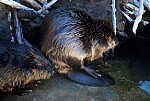Other
Animals
(Birds and Fish have their own page)
Bats: These
small mammals are valuable as they eat bugs, including mosquitos. If they
become
a nuisance near a home, plug up the holes around the house where they have
been residing, purchase or build a bat box, and gradually move the box away
from
the home to a nearby tree or other area. See www.batcon.org
Butterflies: Note their migration through this area. A good book
is "The
Butterflies of Cascadia" by Robert Michael Pyle from the Seattle Audubon
Society. The Oregon Coast Aquarium in Newport has a butterfly garden.
Take notes
about the plants used to attract butterflies, and plant them in your
yard. See www.naba.org

Beaver: Signs of beaver activity - chewed trees - have been noted around
the lake, Thompson Creek, and the Wildwoods wetland open
space by the hospital. If they become a nuisance, call the Oregon Department
of Fish and Wildlife.
Nutria: Nutria are beaver-like mammals, an introduced species that
escaped from farms and now compete with native mammals for habitat. see www.invasivespeciesinfo.gov and www.dfw.state.or.us
Blacktail Mule Deer: Smaller (100-300 pounds) than their elk cousins,
mule deer can be seen round the lake. Brown or gray, they have a white rump
patch with black on the tail and large ears, that rotate to tune in to the
slightest sound. Watch for deer on the roads around the lake.
Roosevelt Elk: The largest member of the deer family found in Oregon,
elk weigh up to 1,000 pounds and travel in herds. Note the ELK CROSSING sign
on Hwy 18 just north of the lake near the Lakeside Golf Course. In October
of 2003, a herd of elk caused considerable damage to a vehicle near Johns Road
in the Neotsu area, north of Devils Lake. Read
the News Times story about Siletz area easements for elk and the Rocky
Mountain Elk Foundation.
Other mammals: Raccoon, opossum, muskrat, and moles are residents. With
the Siuslaw National Forest just east of Devils Lake be aware that larger mammals
could wander into the Devils Lake watershed. Cougar have been spotted at Roads
End, which is not far from Devils Lake. Brown bears can be attracted by garbage,
and frequent the Rock Creek area.
Amphibians: Salamanders and frogs use the lake, but their numbers are
declining. The bull frog has been introduced into the lake.
Bullfrog: An invasive species. http://news.nationalgeographic.com
Western Pond
Turtle: Western pond turtles (Clemmys marmorata) have nearly disappeared
from Washington, largely due to predation by nonnative bullfrogs. Pierce
LakeWorking collaboratively with Seattle's Woodland Park Zoo, Washington
Department of Fish and Wildlife (WDFW) and the U.S. Fish and Wildlife Service
(USFWS), the Oregon Zoo "head-starts" newly hatched turtles gathered
from wild sites. The turtles are nurtured at both zoos for about 10 months
until they grow large enough to avoid being eaten by the non-native bullfrogs
and large mouth bass. www.oregonzoo.org
Macroinvertebrates
(Bugs): In
zoology, an invertebrate is an organism without a backbone or spinal
column.
Macroinvertebrates (or bugs) have degrees of sensitivity to pollutants in the
environment. Macroinvertebrates have been used as indicators of water
quality
for decades. The "Guide to Northwest Aquatic Invertebrates," published
by Oregon Trout, has photos of 45 of the most common macroinvertebrates used
to determine water quality. Brief discussions of the behavior, habitat, key
identification characteristics, and pollution sensitivity are provided for
each
of the taxa. The MidCoast Watersheds Council had volunteers sampling macroinvertebrates
in streams around the lake. PADL members who would like to help can contact
the Watershed Council. See the Masterbug Theater on the kid's page at
www.epa.gov/owow/nps/kids.
Wildlife
Conflicts
Wildlife may become nuisances. Call the Oregon Department of Fish and Wildlife
office (in Newport area, 541-867-4741) For information about preventing animals
from becoming nuisances, go to The Chintimini Wildlife Rehabilitation Center
of Corvallis website at www.chintiminiwildlife.org/LivingWithWild/WildConflict.htm
Photo: Beaver
(Tom Smylie, USFWS)
site map
algae & microscopic | biodiversity | fish | invasive
species | plants | home
Copyright
© 2003-2011 Preservation Association of Devils Lake (PADL).
All
rights reserved.

PO. Box
36
Lincoln City, OR 97367
PADLsteward@wcn.net
